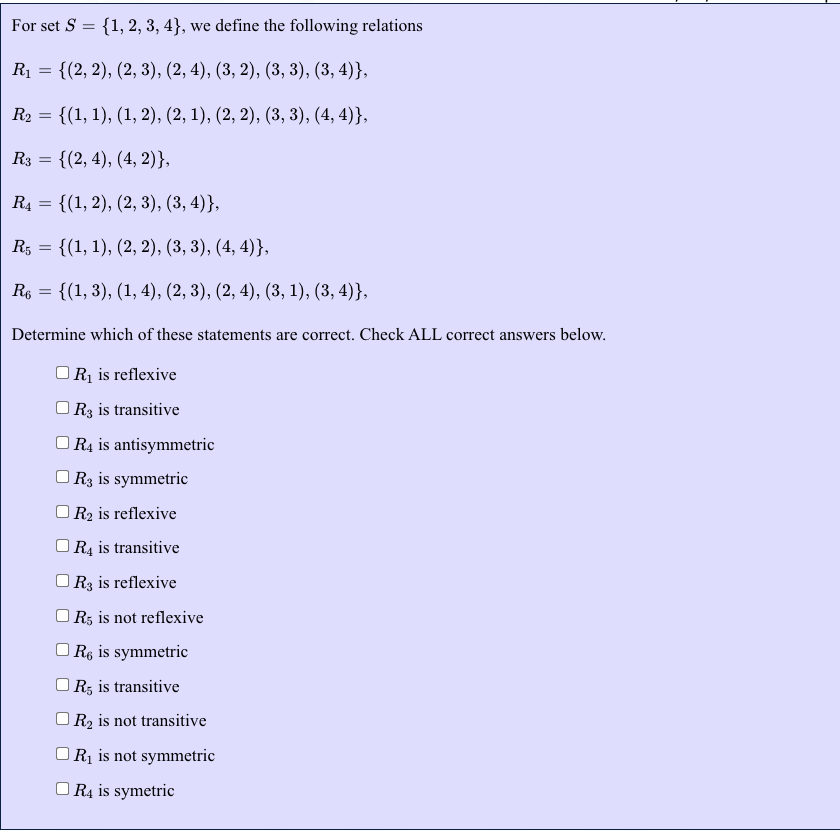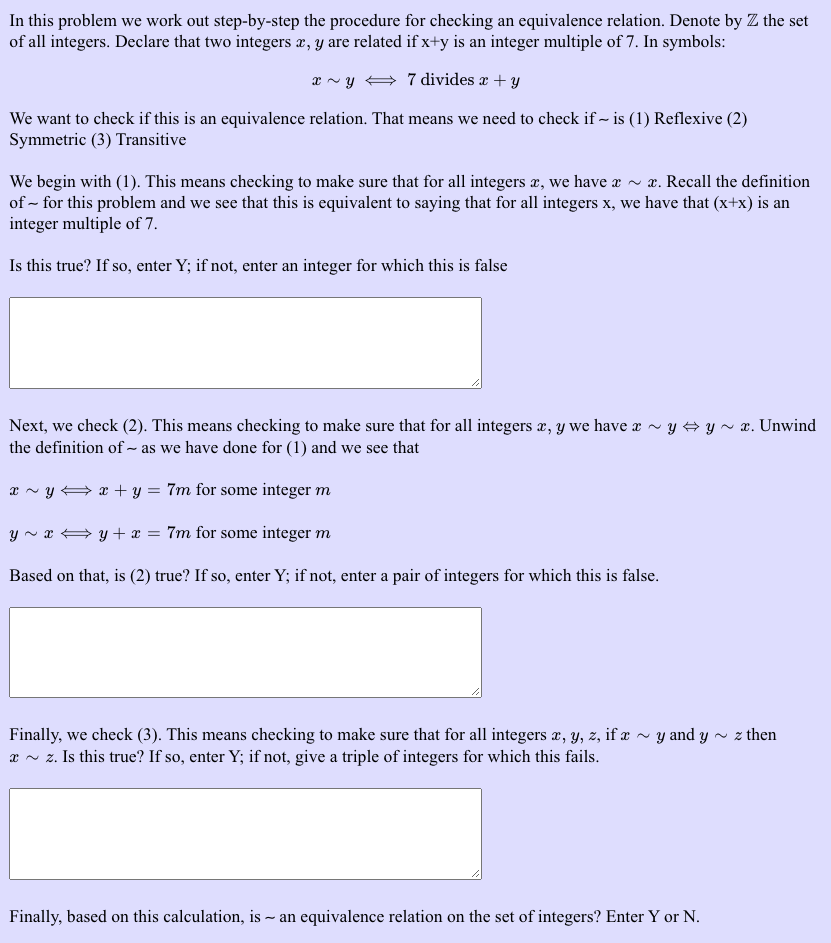For set S = {1, 2, 3, 4}, we define the following relations R1 = {(2,2), (2, 3), (2, 4), (3, 2), (3, 3), (3, 4)}, R2 = {(1, 1), (1, 2), (2, 1), (2, 2), (3, 3), (4, 4)}, R3 {(2, 4), (4, 2)}, R4 = {(1, 2), (2, 3), (3, 4)}, R, = {(1, 1), (2, 2), (3, 3), (4, 4)}, Re = {(1, 3), (1, 4), (2, 3), (2, 4), (3, 1), (3, 4)}, Determine which of these statements are correct. Check ALL correct answers below. ORĮ is reflexive O R3 is transitive O RĄ is antisymmetric | R3 is symmetric | R2 is reflexive O RĄ is transitive | R3 is reflexive R5 is not reflexive O R6 is symmetric R5 is transitive |R2 is not transitive R1 is not symmetric O RĄ is symetric
For set S = {1, 2, 3, 4}, we define the following relations R1 = {(2,2), (2, 3), (2, 4), (3, 2), (3, 3), (3, 4)}, R2 = {(1, 1), (1, 2), (2, 1), (2, 2), (3, 3), (4, 4)}, R3 {(2, 4), (4, 2)}, R4 = {(1, 2), (2, 3), (3, 4)}, R, = {(1, 1), (2, 2), (3, 3), (4, 4)}, Re = {(1, 3), (1, 4), (2, 3), (2, 4), (3, 1), (3, 4)}, Determine which of these statements are correct. Check ALL correct answers below. ORĮ is reflexive O R3 is transitive O RĄ is antisymmetric | R3 is symmetric | R2 is reflexive O RĄ is transitive | R3 is reflexive R5 is not reflexive O R6 is symmetric R5 is transitive |R2 is not transitive R1 is not symmetric O RĄ is symetric
Algebra & Trigonometry with Analytic Geometry
13th Edition
ISBN:9781133382119
Author:Swokowski
Publisher:Swokowski
Chapter10: Sequences, Series, And Probability
Section10.7: Distinguishable Permutations And Combinations
Problem 30E
Related questions
Question
Any and all help greatly appreciated!

Transcribed Image Text:For set S = {1, 2, 3, 4}, we define the following relations
R1 = {(2,2), (2, 3), (2, 4), (3, 2), (3, 3), (3, 4)},
R2 = {(1, 1), (1, 2), (2, 1), (2, 2), (3, 3), (4, 4)},
R3 =
{(2, 4), (4, 2)},
R4 = {(1, 2), (2, 3), (3, 4)},
R5 = {(1, 1), (2, 2), (3, 3), (4, 4)},
Re = {(1, 3), (1, 4), (2, 3), (2, 4), (3, 1), (3, 4)},
Determine which of these statements are correct. Check ALL correct answers below.
ORĮ is reflexive
R3 is transitive
O RĄ is antisymmetric
| R3 is symmetric
| R2 is reflexive
O RĄ is transitive
R3 is reflexive
R5 is not reflexive
O R6 is symmetric
R5 is transitive
|R2 is not transitive
R1 is not symmetric
O RĄ is symetric

Transcribed Image Text:In this problem we work out step-by-step the procedure for checking an equivalence relation. Denote by Z the set
of all integers. Declare that two integers æ, y are related if x+y is an integer multiple of 7. In symbols:
x ~ y + 7 divides x + y
We want to check if this is an equivalence relation. That means we need to check if ~ is (1) Reflexive (2)
Symmetric (3) Transitive
We begin with (1). This means checking to make sure that for all integers æ, we have æ ~ x. Recall the definition
of ~ for this problem and we see that this is equivalent to saying that for all integers x, we have that (x+x) is an
integer multiple of 7.
Is this true? If so, enter Y; if not, enter an integer for which this is false
Next, we check (2). This means checking to make sure that for all integers æ, y we have a ~ y # y ~ x. Unwind
the definition of ~ as we have done for (1) and we see that
x ~ y A x + y = 7m for some integer m
y ~ æ → y + x = 7m for some integer m
Based on that, is (2) true? If so, enter Y; if not, enter a pair of integers for which this is false.
Finally, we check (3). This means checking to make sure that for all integers æ, y, z, if æ ~ y and y ~ z then
æ ~ z. Is this true? If so, enter Y; if not, give a triple of integers for which this fails.
Finally, based on this calculation, is
- an equivalence relation on the set of integers? Enter Y or N.
Expert Solution
This question has been solved!
Explore an expertly crafted, step-by-step solution for a thorough understanding of key concepts.
This is a popular solution!
Trending now
This is a popular solution!
Step by step
Solved in 4 steps with 4 images

Recommended textbooks for you

Algebra & Trigonometry with Analytic Geometry
Algebra
ISBN:
9781133382119
Author:
Swokowski
Publisher:
Cengage

Elements Of Modern Algebra
Algebra
ISBN:
9781285463230
Author:
Gilbert, Linda, Jimmie
Publisher:
Cengage Learning,

Elementary Linear Algebra (MindTap Course List)
Algebra
ISBN:
9781305658004
Author:
Ron Larson
Publisher:
Cengage Learning

Algebra & Trigonometry with Analytic Geometry
Algebra
ISBN:
9781133382119
Author:
Swokowski
Publisher:
Cengage

Elements Of Modern Algebra
Algebra
ISBN:
9781285463230
Author:
Gilbert, Linda, Jimmie
Publisher:
Cengage Learning,

Elementary Linear Algebra (MindTap Course List)
Algebra
ISBN:
9781305658004
Author:
Ron Larson
Publisher:
Cengage Learning

Holt Mcdougal Larson Pre-algebra: Student Edition…
Algebra
ISBN:
9780547587776
Author:
HOLT MCDOUGAL
Publisher:
HOLT MCDOUGAL

Algebra: Structure And Method, Book 1
Algebra
ISBN:
9780395977224
Author:
Richard G. Brown, Mary P. Dolciani, Robert H. Sorgenfrey, William L. Cole
Publisher:
McDougal Littell